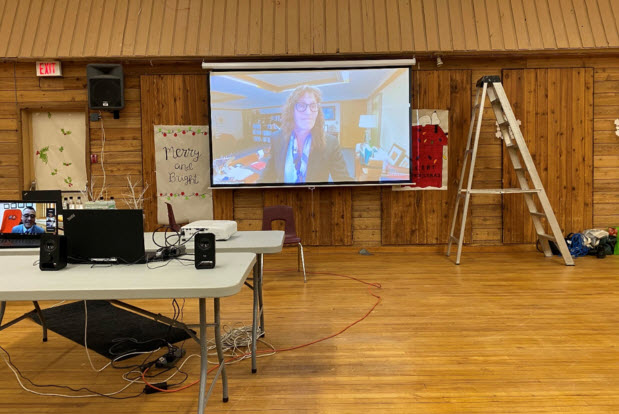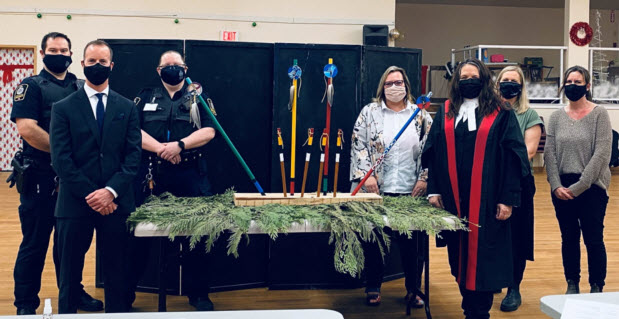Three years ago this week, on December 11, 2020, the Williams Lake Indigenous Court held a “virtual soft opening” due to pandemic health measures. Provincial Court Chief Judge Melissa Gillespie spoke by video-conference, as did the BC premier, First Nations chiefs and elders, and community representatives.
BC’s Indigenous courts sentence Indigenous people who plead guilty, using a restorative and holistic approach focused on healing and balance. In congratulating the people who contributed to the creation of the province’s seventh Indigenous court, the Chief Judge said, “This court will focus on building supportive relationships with Indigenous leaders, elders and the community to bring Indigenous beliefs, culture and traditions in developing healing plans to support Indigenous people who come to the courts”.

Chief Judge Gillespie speaking at the court’s “virtual soft launch”, December 11, 2020
Williams Lake residents and local First Nations had worked long and hard to establish an Indigenous court in the Cariboo. Dave Dickson, retired community safety manager for Williams Lake, his late wife Sandra Dickson, Rod Hawkins, Jim World, First Nations elders, and others involved with restorative justice worked for more than a decade to establish the court. Although COVID complicated things, the court finally opened in December 2020. Housed in the Williams Lake Elks Hall, the court had its first sitting after the virtual opening ceremony and has sat once a month since then.

Judges, sheriffs, and court staff at the virtual soft opening ceremony
An in-person opening ceremony was postponed and it eventually morphed into something a little different. After COVID restrictions relaxed, on June 2, 2023 the Williams Lake Indigenous Court held an in-person ceremony to celebrate its first two and a half years in operation. Judges, lawyers, sheriffs, court staff, police, and others in the justice system joined members of the Yeqox Nilin Justice Society and First Nations representatives for a pipe ceremony, speeches, and lunch.
It was a highlight of the event when a graduate of the court spoke. According to the Williams Lake Tribune, the mother of two young daughters said:
“I was used to the regular court procedures. You don’t really get a chance to speak for yourself and about the social and environmental factors that played a role in what you committed.”
Describing the Indigenous court as close-knit, she described how her first meeting with Provincial Court Judge Linda Thomas and the Court’s elders made her want to do better.
“I was emotional, but it got me to get in touch with my Indigenous roots which I had lost over the years. … It made me into a better person and touched me in a way I cannot really explain. I was at very rock bottom, and I did not see myself getting out of it and now it has pushed me.”
Her remarks, and the changes she has made, prompted a standing ovation.
As the court marks its third anniversary more quietly this week, the people involved can feel satisfaction about their work. People from four Nations, including the Tsilhqot’in, Northern Secwepemc, Southern Dakelh and Métis have come together to make the court work, creating a space incorporating their own traditional practices and healing. Elders may spend a full year or more with a sentenced person, providing support and ensuring accountability to their healing plans.
Judge Linda Thomas, the Provincial Court judge assigned to the Williams Lake Indigenous Court, has said:
“Sentences in Indigenous court bring full meaning and effect to the sentencing principles set out in the Criminal Code and as directed by the Supreme Court of Canada, by using restorative justice principles with a particular emphasis on rehabilitation and healing.
Contrary to the adversarial sentencing process found in traditional courts, sentencing in Indigenous court is a collaborative, cooperative and inclusive process.
Indigenous courts create space for the inclusion of Indigenous values, culture and traditions in the sentencing process, in other words, “standing up” of Indigenous laws.
Indigenous courts recognize the impacts colonization, residential school, the child welfare foster care system, intergenerational trauma, family alienation, and community and cultural disconnection have had on participants. At the same time they recognize participants’ resiliency and strengths.
This does not mean that participants in Indigenous court receive a different sentence or more lenient sentence than another offender with a similar offence, it means that in this court we approach sentencing differently.
Participants are accountable and take responsibility for their actions and the harm they may have caused.
Sentences incorporate a healing plan that includes attending court regularly to review the healing plan with the elders and the court.
The approach in Indigenous courts involves meeting people where they are at, listening to them, giving them a voice, making court a safe place where we do no harm, and providing collaborative support to participants as they strive to meet their personal goals set out in their respective healing plans and to complete their sentences.
Elders and knowledge keepers are an essential component of Indigenous courts. Their participation highlights the importance of community, connection and belonging in healing. As they provide their experience, knowledge and wisdom to guide participants they are true beacons of hope.
Participants tell us that in Indigenous court they feel as if they are treated as “human”: they have a voice and they feel heard.”
More information

